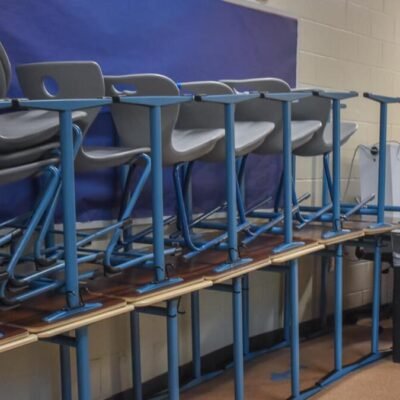n a move that has drawn sharp reactions across the nation, more than 200 employees of the Transportation Security Administration (TSA) were recently fired as part of President Donald Trump’s ongoing push to shrink the size of the federal workforce. This move is the latest in a series of cuts made to various government agencies and reflects the Trump administration’s stance on reducing what it perceives as wasteful government spending.
The TSA, an agency created after the September 11th attacks, has long been a vital part of the nation’s security infrastructure, tasked with screening passengers, their luggage, and cargo at airports across the United States. The layoffs have raised concerns not only about the fate of the employees affected but also about the potential security risks that could arise from a smaller workforce in such a critical area.
This development comes on the heels of multiple efforts by President Trump’s administration to reduce the size and cost of the federal government, a stance that has been met with mixed reactions. While some believe reducing government personnel is essential for fiscal responsibility, others warn that cutting back on essential agencies like the TSA could have serious consequences for national security.
The Trump Administration’s Push to Cut Government
President Trump’s administration has long sought to make the government leaner and more efficient by cutting back on the number of federal employees. Trump’s initial budget proposal in 2017 included plans to cut several thousand government jobs in an effort to reduce the deficit and trim government spending. The TSA, which currently employs tens of thousands of workers, was among the agencies that faced significant cuts.
The latest decision to lay off over 200 TSA employees is part of a larger initiative aimed at reducing the size of the government. The move has raised alarms among critics, who argue that cutting jobs at an agency responsible for the safety of the American public could undermine national security.
For years, the TSA has been a central figure in ensuring the safety of air travel. Its employees screen millions of passengers each year, ensuring that dangerous items are not brought on board airplanes. With the new layoffs, critics fear that the agency will struggle to maintain these safety standards, potentially leading to longer wait times at airports and reduced efficiency in screening procedures.
The Role of the TSA in Airport Security
The TSA was established in the wake of the September 11th terrorist attacks to provide security at airports across the country. The agency has a critical mission: to prevent terrorists from bringing weapons or explosives onto commercial flights. TSA officers work tirelessly to screen passengers, luggage, and cargo to ensure that no dangerous items make it past security.
TSA workers perform many roles, from inspecting bags to monitoring metal detectors and conducting pat-downs. They also operate sophisticated imaging machines designed to detect hidden threats. The agency’s ability to carry out these tasks efficiently relies on a large and well-trained workforce. As travel volumes increase, so too does the pressure on TSA workers, making the recent layoffs particularly concerning.
The TSA’s responsibilities have grown more complex as the aviation industry has evolved. The agency has had to stay one step ahead of evolving terrorist threats, which has meant constant training and technological upgrades. With more than 200 employees now let go, many are wondering how the agency will continue to keep up with its security obligations.
Experts argue that cutting staff could lead to longer wait times at airports, as fewer workers would be available to screen passengers. This could not only frustrate travelers but also lead to greater security risks, as rushed screening procedures might not be as thorough. Furthermore, experts warn that a smaller workforce could lead to an increased burden on the remaining TSA employees, who may be forced to work longer hours and take on more responsibilities.
Employee Reactions and Impact
The layoffs have had a direct impact on TSA employees, many of whom are frustrated by the decision. Several TSA workers who lost their jobs expressed confusion and disappointment, noting that the agency’s staff was already stretched thin before the cuts.
“We already had a difficult job, especially during peak travel times,” said one TSA worker who was recently laid off. “Now, with more employees gone, it’s going to be even harder to keep things running smoothly. I’m just not sure how we can do our job as effectively with fewer people.”
The TSA employees who remain on the job are facing increased pressure as they attempt to cover for their colleagues who were laid off. In the coming months, these workers will likely face longer shifts, heavier workloads, and the constant challenge of ensuring the safety of travelers while dealing with reduced resources.
For the employees who lost their jobs, the layoffs have caused significant hardship. Many of the affected workers have been employed at the TSA for years, and the sudden loss of income has created uncertainty for them and their families.
The Larger Debate Over Federal Workforce Cuts
The TSA layoffs are part of a broader debate about the size and role of the federal government. President Trump’s administration has made it clear that it believes the federal government is too large and inefficient. In an effort to streamline operations, the administration has pushed for reducing the number of federal workers across various departments and agencies.
Supporters of these cuts argue that reducing the size of the federal workforce will save taxpayers money and make the government more efficient. They contend that government agencies, including the TSA, can operate more effectively with fewer employees, especially in an era where technology can help automate certain tasks.
However, critics of the cuts argue that reducing the size of critical agencies like the TSA could undermine national security. They point to the increasing complexity of security threats and the growing number of passengers traveling by air as reasons to maintain a strong TSA workforce. Cutting back on employees at an agency responsible for public safety, they argue, is a risky move that could have far-reaching consequences.
“While it’s important to manage taxpayer dollars responsibly, we cannot afford to compromise on safety,” said one security expert. “The TSA plays an essential role in preventing terrorist attacks and ensuring the safety of air travel. Cutting staff is a dangerous gamble.”
The Path Forward: Balancing Efficiency and Safety
As the Trump administration continues its push to cut federal workers, it is important to consider whether these cuts are truly in the best interest of national security. While some argue that the TSA could benefit from modernization and reform, others worry that eliminating jobs could jeopardize the agency’s ability to carry out its mission effectively.
One possible solution is to invest in new technologies that can assist TSA workers in their duties. Advanced screening technologies, such as automated systems and biometric identification, could help reduce the workload on employees while maintaining or even improving security standards. However, these technologies come with significant upfront costs, and the government may be reluctant to invest in them while focusing on cutting spending.

How Inflation is Affecting American Families and Businesses
Experts also suggest that the government could target cuts more strategically, eliminating non-essential administrative positions rather than directly reducing the number of security personnel. This approach could allow the TSA to maintain its security capabilities while still meeting the administration’s budgetary goals.
What Lies Ahead for the TSA?
The TSA’s future remains uncertain as it faces the challenge of adapting to a reduced workforce. While the agency continues to carry out its vital mission of protecting air travelers, the loss of over 200 employees could have lasting effects on its operations. As the Trump administration moves forward with its plans to cut the federal workforce, it will be crucial to monitor how these decisions impact the TSA and the safety of air travel.
As the debate continues, one thing is clear: the TSA will need to find new ways to ensure that it can carry out its mission efficiently and effectively with fewer employees. The challenge will be finding a balance between reducing government spending and maintaining the high security standards that travelers rely on.




